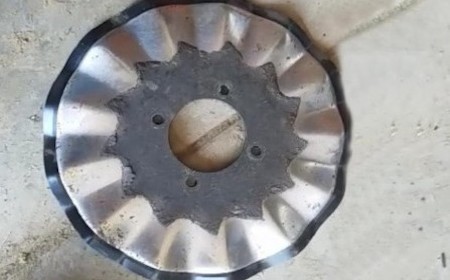By Justin Brackenrich
Don’t let improper maintenance in April limit your harvest potential in October.

No-till coulter wheels from planter. Used on top of new wheel showing wear of wheel. Image Credit: W. Thiele, Thiele Dairy Farm, Cabot, PA
Every April, the time comes to start planting corn, drilling spring grains, thickening forage stands and getting soybeans in the ground. Before you plant, it is always a good idea to calibrate your planter or drill, check for wear on the equipment, and do an overall inspection to make sure all things are in good working order. This is a perfect activity for rainy days spent in the shop or the machine shed, looking for drier days.
Many resources are available to help you and your helpers get through all these yearly checks. Many of the major Land Grant Universities or the equipment manufacturers have tutorials or fact sheets about the steps, many of which are excellent. However, many of these often advise for soil types, weather conditions, and cropping systems that are more suitable for their areas where they are written. These are things like recommended down pressure, different opening and closing wheels, fertilizer application systems, and the equipment itself. They are good references, but it is best to get information for your area, soils, equipment, and planting practices when making final modifications.
Penn State Extension Field and Forage Crop team has an abundance of resources designed to help produces check their equipment from front to back, and top to bottom.
No-Till Drill Calibration
No-till drills come with a book or guide that will give you rough estimates of planting rates. Often these are based on seed size and a rough estimate of seeds per pound. These estimates will get you close to where you should be set when planting, but there can still be a lot of error, especially with small seeds. Even with these book calibrated rates, manual calibration is important to make sure that you are getting the proper seeding rate. Planting the proper rate is important so that germination percentages can be determined for later information and stand assessment, as well as, ensuring you have enough seed to cover your acreage.
To calibrate a drill, Penn State has a developed set of written instructions, Calibration of Grain/ Seed Drills and a video, Grain Drill Calibration . Both tools will be very helpful for a first tie calibrator, or an old hand that needs a refresher may learn a new trick. I recommend that producers watch the video and get a good feel for the process and then take a copy of the written instructions to the shed for more detail while they preform the task.
Planter Setup and Maintenance
The planter is a very versatile tool in the arsenal of the agricultural producer, when it is calibrated and maintained correctly. Many producers use it to plant corn and soybeans, and it can be used in conventional and no-till systems. Penn State made a video series, located at the Penn State Extension Field and Forage Crop Team YouTube channel, that goes through the five steps of planter setup and maintenance. While on this channel, you can find lots of other information on the benefits of no-tilling, residue management, and soil qualities.
If you are using your planter in a no-till system, Dr. Sjoerd Duiker has a Planter Performance in No-Till article which outlines all the important components of the planter and how they can be adjusted to operate more efficiently in no-till systems. Zach Larson also wrote and article, Where to Start Considerations for Planter Upgrades . While it may be too late close to planting season to start major modifications, this article will provide you with details on the benefits of planter modifications for next year.
Planters and drills are as useful and as efficient as we can make them. As the producer and operator, it is your job to make sure that they are working for you in the way they are designed. Following calibration and maintenance tips will ensure the equipment is functioning and you are able to get the most economic return out of it, and your planting. Remember, you can only harvest as well as you plant.
Source : psu.edu